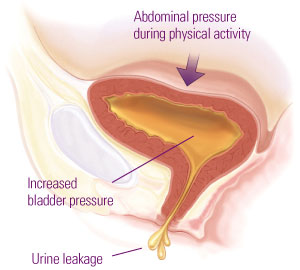Stress urinary incontinence (SUI) is the involuntary loss of urine with straining or activity. You may find that you leak with coughing, sneezing, laughing, or exercise. This type of incontinence is caused by weakening of the muscles that support the urethra and bladder. Common causes of this weakening include age, childbirth, trauma, or hormone changes.
There are many different options to treat stress urinary incontinence.
- Do nothing. Urinary incontinence is not life threatening. You do not need management for it if you are not bothered.
- Pelvic floor physiotherapy/pelvic floor muscle training. A physiotherapist will teach you some exercises to try and strengthen the muscles of the pelvic floor.
- A pessary. This is a device that is inserted into the vagina and applies pressure to the base of the bladder and urethra to try and prevent leakage.
- Some patients will find some mild benefit from a medication called duloxetine. This is an anti-depressant medication, however in smaller doses it can help some patients with SUI.
- Urethral bulking agents. This is a medication which is injected under the lining of the urethra to try to “bulk” it up to prevent urine leakage.
- Midurethral sling. This is a mesh device that is placed under the urethra to recreate the structural support of the muscles of the pelvis. It is the most common surgical procedure performed for SUI.
- Fascial sling. This is very similar to the Midurethral sling, however instead of mesh, we use fascia, which is from your own body.
- Burch colposuspension. This is a surgery performed by the gynecologists, which raises the sides of the vagina to try and support the bladder and urethra.
The most common surgical procedure we perform is the midurethral sling.
Procedure:
- This is a day procedure. You will go home after your surgery.
- You will go to sleep with the anesthetist for the operation.
- A small incision is made in the front of the vagina as well as two tiny incisions just above your pubic bone, below your bikini line.
- A device is used to pass the mesh under the urethra and behind the pubic bone.
- Once the mesh is correctly positioned, we close the incisions with dissolving stitches.
- The procedure takes about 30 minutes.
There are a few risks to consider:
- Pain in the vagina or pelvis
- Pain during intercourse
- Difficulty emptying your bladder
- Urinary tract infections
- Skin infection
- Erosion of the mesh. This occurs when the mesh migrates to other parts of the pelvis, such as in the urethra, bladder, or vagina.
- Bleeding or bruising after the procedure.
After the procedure:
- We will make sure that you can void after the procedure before you go home.
- You will be discharged with antibiotics as well as medication for pain and a stool softener.
- You may shower when you get home.
- No Baths, hot tubs, or swimming pools for two (2) weeks
- ABSOLUTELY NO HEAVY LIFTING OR STRAINING FOR SIX (6) WEEKS.
- Do not lift anything heavier than 10 lbs
- Nothing in the vagina for six (6) weeks.
Other Patient Information:
- Please download Boston Scientific's pamphlet on Female Stress Urinary Incontinence for additional information here.
- Consider a new laser therapy to promote healthier vaginal tissue, the MonaLisa Touch.

